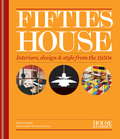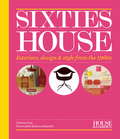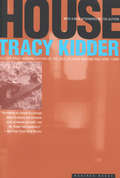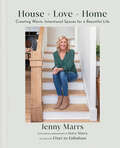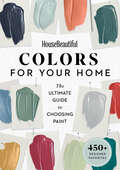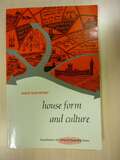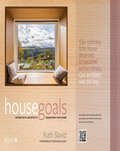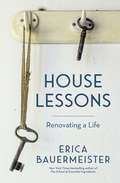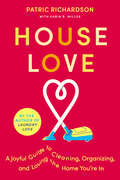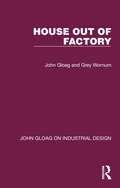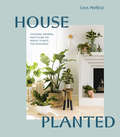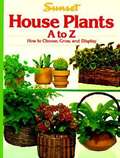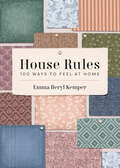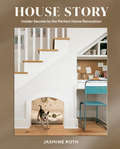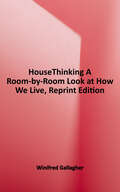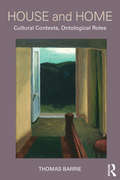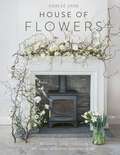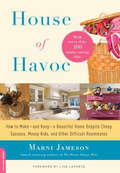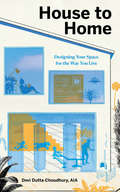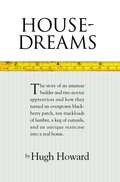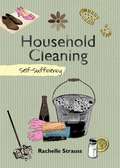- Table View
- List View
House & Garden Fifties House (House & Garden)
by Catriona GrayThe post-war consumer boom of the 1950s, coupled with a desire for new, innovative design resulted in one of the most exciting decades in the history of interiors - a visual revolution that was captured on the pages of British House & Garden.In Fifties House, mid-century modern enthusiast Catriona Gray has drawn on the magazine's peerless archive, curating the best illustrations and photographs to show how the use of colour, pattern, homewares and furniture evolved through the decade. The homes of key tastemakers are featured including Le Corbusier, Giò Ponti, Terence Conran and Hans and Florence Knoll. The first title in the new Decades of Design series, House & Garden Fifties House is required reading for mid-century modern enthusiasts, collectors and decorators in search of inspiration from the most influential homes of the past.
House & Garden Sixties House: Interiors, design & style from the 1960s (House & Garden)
by Catriona Gray House & GardenFrom Pop art to Op art, plastic furniture to bubble-gum paint colours, the Sixties saw a new wave of interior design that was closely linked to popular culture and fashion, becoming increasingly youth-oriented and playful to appeal to the new generation of baby-boomers. In Sixties House, mid-century modern enthusiast Catriona Gray has drawn on the magazine's peerless archive, curating the best illustrations and photographs to show how the use of colour, pattern, homewares and furniture evolved through the decade. The homes of key tastemakers are featured including Bridget Riley, Mary Quant, David Mlinaric, Barbara Hulanicki of Biba and David Bailey. The second title in the new Decades of Design series, House & Garden Sixties House is required reading for mid-century modern enthusiasts, collectors and decorators in search of inspiration from the most influential homes of the past.
House (Random House Reader's Circle Ser.)
by Tracy KidderIn the New York Times bestseller House, Pulitzer Prize–winning author Tracy Kidder takes readers to the heart of the American Dream: the building of a family's first house with all its day-to-day frustrations, crises, tensions, challenges, and triumphs.In Kidder's "remarkable piece of craftsmanship in itself" (Chicago Tribune), constructing a staircase or applying a coat of paint becomes a riveting tale of conflicting wills, the strength and strain of relationships, and pride in skills. With drama, sensitivity, and insight, he takes us from blueprints to moving day, shedding light on objects usually taken for granted and creating a vivid cast of memorable characters in the process."The making of a house is a strange blend of dreams and mundane work, of heaven and earth, and Mr. Kidder has explained it."??—??New York Times Book Review
House + Love = Home: Creating Warm, Intentional Spaces for a Beautiful Life
by Jenny MarrsA welcoming guide to transforming any home into a beautiful, inviting space—from the hosts of the hit HGTV show Fixer to FabulousBeloved by millions of fans, Jenny and Dave Marrs from HGTV&’s Fixer to Fabulous have built and remodeled hundreds of homes over the last two decades, creating joyful, warm, and thoughtful makeovers in each one. At its heart, the Marrs believe a home needs to express the intentions of its inhabitants. They also believe your home should be beautiful—not based on how the latest trends define beauty, but as a reflection of who you are. House + Love = Home is filled with:• Stunning Photos Throughout: Filled with never-before-seen gorgeous photographs of interiors, exteriors, family shots and more• Intentions: House + Love = Home highlights the twelve areas within a home that Jenny and Dave often remodel and show how each unique space can have intentional design elements that express the personalities of those who live there• Transformational Tips: these tips take a specific part of a home—everything from doors and shutters to lighting and flooring—and shows the most effective ways to enhance that areaAlongside gorgeous photos of the Marrs&’ restored farmhouse, their delightful kids, and many other spaces they&’ve reimagined, Jenny and Dave share their personal journey of establishing their own home, an ever-growing family and a busy, sustainable business. Woven throughout are wonderful essays by Jenny about their lives on the Marrs farm and how they seek to live intentionally with a deep abiding faith and purpose. As Jenny says, &“Our company motto is the simplest of equations: House + Love = Home. Beautiful spaces are most often imperfect and full of character. Just like people. Perfection is never the goal. Living well is.&”
House Beautiful Colors for Your Home: The Ultimate Guide to Choosing Paint
by House BeautifulBased on House Beautiful&’s popular color column, this pocket-sized handbook shows how a simple coat of paint can set the mood and add a designer's touch in any room. This gorgeous primer showcases more than 450 colors selected by top interior designers who explain how and why they chose these particular paints—along with swatches complete with manufacturer, name, and number, to help you pick the perfect pigment. Exploring everything from bold saturated hues to more soothing shades and essential neutrals, the designers offer special insight into what makes color work and how it influences the different spaces. The insider advice, plus stunning images of inspiring rooms, will help you select the ideal colors you&’ll enjoy for years.
House Beautiful Style 101: 400 Designer Secrets to a Beautiful Home
by Lisa CreganWant to change your home? Baffled by all the available design choices? House Beautiful helps you define your style--and get the look you love in every room.With advice and insider tips from dozens of designers, this entry in the magazines popular pocket guide series (which includes Colors for Your Home and Fabrics for Your Home) simplifies all your decorating decisions. A fun visual quiz helps you get started. Then an overview of hallmark elements and designers for five distinct decorating styles leads into room-by-room insider advice on selecting everything from furnishings and colors to carpets, window treatments, and lighting. Its a fresh approach to decorating!
House Form And Culture (Geography Ser.)
by Amos RapoportAn historical approach to the broad variety of primitive and peasant dwellings and the forces that affect them
House Goals: Design with architects, transform your home
by Ruth SlavidWhat would you do if you could reinvent your home? A link to the garden, to bring nature closer. A re-thought layout, that complements your lifestyle. A greener home, for a sustainable future (and lower energy bills). More space. Better space. You probably know what is wrong with your house, but do you really know what would improve it? Architects do. Even better, they can design a home that works for you, with ideas and solutions that you may not yet have considered. This stunningly illustrated book showcases the best examples of what can be achieved when homeowners collaborate with RIBA-certified architects to realise their House Goals. Sorted by motivation, it breaks down how architects can address these universal problems in unique, bespoke ways that suit their clients, while providing inspiration for your own home. Crucially, House Goals fully explains the process of working with architects – from first contact to completion – to ensure you know exactly what you’re getting into, and how to make the most of it. Features: Examples of projects in Georgian, Victorian, Edwardian, inter-war and post-war homes. A range of scales, from one-bed flats and split-level maisonettes to two-up, two-down terraces and cosy cottages, elegant town houses and detached homes as well as interesting conversions and garden rooms. Rural and urban locations ranging from hamlets to big cities, covering: London, Norfolk, Cheshire, Sussex, Herefordshire, Yorkshire, Oxfordshire and more. Work from more than 30 architects, including: Arboreal Architecture, Bradley Van der Straeten Architects, Gagarin Studio, IF_DO, Knox Bhavan and nimtim architects. With a foreword by Kevin McCloud.
House Gods: Sustainable Buildings and Renegade Builders
by Jim KristoficOur buildings are making us sick. Our homes, offices, factories, and dormitories are, in some sense, fresh parasites on the sacred Earth, Nahasdzáán. In search of a better way, author Jim Kristofic journeys across the Southwest to apprentice with architects and builders who know how to make buildings that will take care of us. This is where he meets the House Gods who are building to the sun so that we can live on Earth. Forever.In House Gods, Kristofic pursues the techniques of sustainable building and the philosophies of its practitioners. What emerges is a strange and haunting quest through adobe mud and mayhem, encounters with shamans and stray dogs, solar panels, tragedy, and true believers. It is a story about doing something meaningful, and about the kinds of things that grow out of deep pain. One of these things is compassion—from which may come solace. We build our buildings, we make our lives—we are the House Gods.
House Lessons: Renovating a Life
by Erica BauermeisterFROM NEW YORK TIMES BESTSELLING AUTHOR ERICA BAUERMEISTER COMES A MEMOIR ABOUT THE POWER OF HOME—AND THE TRANSFORMATIVE ACT OF RESTORING ONE HOUSE IN PARTICULAR. &“I think anyone who saves an old house has to be a caretaker at heart, a believer in underdogs, someone whose imagination is inspired by limitations, not endless options.&” In this mesmerizing memoir-in-essays, Erica Bauermeister renovates a trash-filled house in eccentric Port Townsend, Washington, and in the process takes readers on a journey to discover the ways our spaces subliminally affect us. A personal, accessible, and literary exploration of the psychology of architecture, as well as a loving tribute to the connections we forge with the homes we care for and live in, this book is designed for anyone who&’s ever fallen head over heels for a house. It is also a story of a marriage, of family, and of the kind of roots that settle deep into your heart. Discover what happens when a house has its own lessons to teach in this moving and insightful memoir that ultimately shows us how to make our own homes (and lives) better.
House Love: A Joyful Guide to Cleaning, Organizing, and Loving the Home You're In
by Patric Richardson Karin MillerDiscover the joy of cleaning with this cheery and thoughtful guide to tidying up and turning your house into a home.Patric Richardson is known as “The Laundry Evangelist,” but his genuine love for household chores extends far beyond the laundry room. His philosophy is simple: tidying up is a privilege and a task you do for those you love (including yourself), and there are a million ways to infuse joy into the everyday tasks behind maintaining a home.House Love is his sunny guide to freshening up every inch of the house—from the entryway to the attic, the backyard to the bedroom. Patric shares his best design inspiration, DIY projects, and, of course, cleaning tips, so you can fall in love with your home all over again—or for the very first time!This book also grants you permission to shake things up. Keep bath salts in a cookie jar? Sure. Display a surprising mishmash of pillows? You bet. Discover your personal design style? He helps you do that too. Plus, Patric’s cleaning genius will change your life, with expert advice like:Which three cleaning tools are worth splurging onHow to create a powerful (and antibacterial) cleaning spray with lemon and thymeWhat exactly to clean when you only have 10 minutes to spareComplete with fun-to-clean-to playlists, charming recipes, and even step-by-step instructions for cleaning every type of room, House Love brightens up life’s most common chores. With this book, you’ll learn new and novel ways to transform your home, and Patric’s entertaining stories, good humor, and genuine warmth will guide you every step of the way.
House Out of Factory (John Gloag On Industrial Design Ser.)
by John Gloag Grey WornumOriginally published in 1946, when Britain was facing a post-war housing crisis, this book dealt with the issue of the factory-produced house in being part of the solution for housing people in an affordable manner and a short time-scale. The book, aimed at both lay-people and technicians discusses aspects of pre-fabricated housing such as comfort, standardisation and aesthetics. The book is illustrated with 48pp of black and white plates.
House Planted: Choosing, Growing, and Styling the Perfect Plants for Your Space
by Lisa MuñozGreen up your living space with this bright, fresh, stylish introduction to choosing, caring for, and designing with houseplants.Get ready to transform your humble abode! Whether you have a funky bohemian den, a chic minimalist loft, or a closet-sized rental, indoor plants will bring a whole new level of warmth, comfort, and style into your home. In House Planted, interior plant designer Lisa Muñoz guides you step by step and room by room through picking the perfect plant for the perfect spot and incorporating plants into your indoor decor. You'll find info on plants that are hard to kill, hanging plants, succulents, air plants, and more. There are creative ideas for displaying plants, tips on caring for your new leafy friends, and primers on potting and troubleshooting. Casual and easy-going, with attainable styles and simple instructions, this short and sweet book of inspiration has everything you need, and nothing you don't, to start you off on an adventure in better--and greener--living.
House Plants
by Sunset Publishing StaffCatalogues common house plants from A to Z and provides tips for proper care.
House Plants for the Purple Thumb
by Maggie BaylisMaggie Baylis provides a how-to book for houseplants.
House Rules: 100 Ways to Feel at Home (Rules)
by Emma KemperWe all want a home that is as much tailored to our lives as it is inviting (and impressive) to guests. House Rules helps you achieve both, encouraging you to develop and elevate your personal style, putting it into practice with the tenets of interior design. In House Rules, Emma Beryl Kemper, principal of her eponymous interior design firm, breaks down this often intimidating topic, defining 100 insightful rules to help you transform your space into a home you&’ll never want to leave. Organized into categories—some broad, like Gathering Inspiration and Space Planning, others more distinct and detailed, like Window Treatments and Coverings—these guidelines include tips on every step of transforming your space. If you don&’t know where to begin, Rule #1 eases you in with creating a mood board. Time to change up your walls? Rule #36 helps you avoid choosing paint or wallpaper that clashes with other colors already present in that room. When you need a quick tweak, Rule #99 explains the impact a single throw pillow can have on a room. Want to set the mood at your next dinner party? Rule #52 is all about up lights and how to implement them. Whether you prefer a sleek minimalist vibe or a colorful eclectic bohemian style, Emma&’s rules apply, and they will bring your vision to life. Adorned with chic, painterly line drawings throughout, this book will look perfect on display in your living room—once it&’s designed to perfection.
House Story: Insider Secrets to the Perfect Home Renovation
by Jasmine RothThe star of HGTV&’s Hidden Potential and HELP! I Wrecked My House offers a rare glimpse behind the TV show curtain, inviting readers into her world with super-simple advice that takes all the guesswork and stress out of any home project. &“Renovating a home can be mega intimidating, but not if you surrender to the wisdom of your new guru, Jasmine Roth. She knows all.&”—Jonathan AdlerFinding your style is the first step to creating your dream home, whether you&’re buying a new place, designing ground-up construction, or simply sprucing up the décor on a rental. Through her clear descriptions of four common design types and their many style subsets, along with thought-provoking questions and worksheets, Jasmine helps you create a cohesive feel with your home décor. She also includes helpful information on curb appeal and outdoor lighting (the most forgotten detail of your home), the science of knocking down walls, creative solutions to the five most common layout needs, floor finishes and wall treatments, everything kitchen and bathroom, and fun ways to personalize your space with DIY projects and unique bookshelf styling. With hundreds of stunning photographs of Roth-designed interiors, House Story is a lush exploration of what is possible for you and your home, whatever the size and budget.
House Thinking: A Room-by-Room Look at How We Live
by Winifred Gallagher“A fascinating book that investigates and explains the emotional impact our homes have on our lives. House Thinking . . . guides the way for us to live out our most creative selves at home.” —Wendy Goodman, interior design editor, New York magazine IKEA, Ethan Allen and HGTV may have plenty to say about making a home look right, but what makes a home feel right? In House Thinking, journalist and cultural critic Winifred Gallagher takes the reader on a psychological tour of the American home. By drawing on the latest research in behavioral science, an overview of cultural history, and interviews with leading architects and designers, she shows us not only how our homes reflect who we are but also how they influence our thoughts, feelings, and actions. How does your entryway prime you for experiencing your home? What makes a bedroom a sensual oasis? How can your bathroom exacerbate your worst fears? House Thinking addresses provocative questions like these, enabling us to understand the homes we've made for ourselves in a unique and powerful new way. It is an eye-opening look at how we live . . . and how we could live.
House and Home: Cultural Contexts, Ontological Roles
by Thomas BarrieHouse and home are words routinely used to describe where and how one lives. This book challenges predominant definitions and argues that domesticity fundamentally satisfies the human need to create and inhabit a defined place in the world. Consequently, house and home have performed numerous cultural and ontological roles, and have been assiduously represented in scripture, literature, art, and philosophy. This book presents how the search for home in an unpredictable world led people to create myths about the origins of architecture, houses for their gods, and house tombs for eternal life. Turning to more recent topics, it discusses how writers often used simple huts as a means to address the essentials of existence; modernist architects envisioned the capacity of house and home to improve society; and the suburban house was positioned as a superior setting for culture and family. Throughout the book, house and home are critically examined to illustrate the perennial role and capacity of architecture to articulate the human condition, position it more meaningfully in the world, and assist in our collective homecoming.
House of Flowers: 30 floristry projects to bring the magic of flowers into your home
by Ashlee JaneBring the joy of flowers into your home with 30 stunning projects for every season.From spring planters to summer floral crowns and autumn vase arrangements to winter wreaths; life is better with flowers all year round. With clear, step-by-step instructions, expert florist Ashlee Jane leads you through her inspirational ideas for floral designs to bring the calming presence of flowers and foliage into your home.There is something for every occasion here, from small place settings and everyday bouquets to show-stopping displays for a mantlepiece or staircase, and everything in between. Including styling tips, a directory of favourite flowers and gorgeous ideas on every page, you will be inspired to fill your home with flowers throughout the year.
House of Flowers: 30 floristry projects to bring the magic of flowers into your home
by Ashlee JaneBring the joy of flowers into your home with 30 stunning projects for every season.From spring planters to summer floral crowns and autumn vase arrangements to winter wreaths; life is better with flowers all year round. With clear, step-by-step instructions, expert florist Ashlee Jane leads you through her inspirational ideas for floral designs to bring the calming presence of flowers and foliage into your home.There is something for every occasion here, from small place settings and everyday bouquets to show-stopping displays for a mantlepiece or staircase, and everything in between. Including styling tips, a directory of favourite flowers and gorgeous ideas on every page, you will be inspired to fill your home with flowers throughout the year.
House of Havoc: How to Make--and Keep--a Beautiful Home Despite Cheap Spouses, Messy Kids, and Other Difficult Roommates
by Marni JamesonThe cupboards are overflowing, the linen closet holds towels and tools, and your once tidy family room might as well come with a ringmaster. But that’s called living, right? Wrong! <P><P>Marni Jameson is here to prove that you can turn a hectic home into a haven—and do so without being voted off the island. With chapters such as “Kids are Great—They Only Dismantle Your Home One Piece at a Time,” you’ll laugh as you learn whether to opt for solids or patterns; what constitutes “indestructible flooring”; how to organize your house from top to bottom; and how to decorate so home appeal goes up and blood pressure goes down.
House to Home: Designing Your Space for the Way You Live
by Devi Dutta-ChoudhuryHave you been thinking about how to make your house into a true home? Or are you buying a house that needs the same attention? Where do you begin? This book will get you started, see you through it, and make home design doable rather than daunting.Charming and accessible, House to Home is a beginner-friendly guidebook for creating a home that supports your life the way you live it. With practical, hard-earned wisdom, architect Devi Dutta-Choudhury guides you through the process from the foundation up.Dive into home design with charts, questionnaires, and sketch pages that help you confidently approach and define your renovation. With Dutta-Choudhury&’s relatable expertise, you&’ll begin to think more like an architect. From understanding the site, working with architects, and being your own contractor to deciding when to redesign and when to leave alone, this book teaches core concepts about privacy, use of space, lighting, access, and more. Whether it&’s just one room or your whole house, House to Home is here to help.
House-Dreams
by Hugh HowardImagine a house built and tailored to your every need and personal taste. Hugh Howard dreamed of such a house, and when he and his wife, Betsy, learn that they're expecting their second child, he seizes the opportunity to build a home for their growing family. Fifteen months later and just in time for the winter holidays, Howard, exhausted and wildly over his budget, completes their home-a fine 2,500-square-foot Federal-style house. And each piece has a story, from the cut nails that come from Howard's old elementary school janitor to the staircase that comes from a parsonage built just after the Civil War. Howard discovers that all his planning and hard work earn him a house, yes, but he also gains a community of new friends-the people who help him along the way. There's Charlie, whose ancestors helped establish the upstate New York hamlet where they build the house; Ralph, a third-generation mason, who constructs a remarkable Russian heater; and Robbie, an eccentric Irish landscaper who has his own peculiar way of designing a garden. HOUSE-DREAMS is for readers who spend weekends improving their houses, hardware store die-hards, and the millions who regularly tune in to the Home Garden Network and PBS's This Old House.
Household Cleaning: Self-Sufficiency (Self-Sufficiency Series)
by Rachelle StraussMost conventional store-bought cleaning products are packed full of chemicals, many of which are harmful to the environment and your health, let alone your wallet. You'll be pleasantly surprised to discover that your kitchen cupboard already stocks the alternative supplies you'll need to transform your home into a clean, safe, and fresh-smelling haven! Lemons, salt, vinegar, baking soda, and club soda are just some of the natural ingredients used to clean the kitchen, bathroom, bedroom, floors, and everything in between. Turn a chore into a pleasure and discover a whole new way to clean! About the Self-Sufficiency Series: More and more Americans are becoming concerned about living a healthier land more environmentally-friendly lifestyle. Whether it's moving to the country and starting over on a whim or just making city-living a little simpler and easier, the "Green" movement is changing the way we live our day-to-day lives. Skyhorse's new Self-Sufficiency handbooks are meant to help-offering advice on what to do, how to do it better, and how to save money as well. This is a beautifully-illustrated series made even more beautiful because its goal is to help everyone live in a more earth-friendly fashion.
